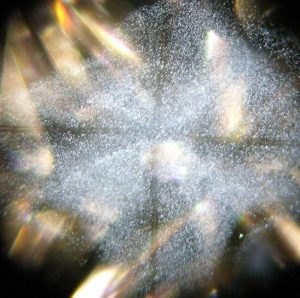What is Transparency?
Transparency, also called pellucidity, is the material property of allowing light to pass through. In mineralogy, another term for this property is diaphaneity.
Transparency, or pellucidity refers to the quality of the diamond crystal, allowing light to pass through a material without significant scattering or absorption.
In the context of diamonds, transparency is an important characteristic that affects the appearance and value of the diamond. Diamonds are prized for their high level of transparency, which is a result of their unique crystal structure and chemical composition.
Diamonds are made up of carbon atoms arranged in a crystal lattice structure ( C4 ) being the purist. Which is why they are classified as a type2A of mineral. The arrangement of atoms in the lattice is very tightly packed, which makes diamonds exceptionally hard and durable.
It also means that the lattice is very regular and uniform, which allows light to pass through it easily without being scattered or absorbed.
A diamond with high pellucidity is free from inclusions or blemishes that can obstruct the passage of light through the diamond, which can cause it to appear less transparent. ( no clouds or graining ) The highest grade being Excellent and the lowest Poor.
The transparency of a diamond is affected by a number of factors, including its cut, clarity, and colour. A well-cut diamond will have a symmetrical shape and well-proportioned facets that allow light to enter and exit the stone at the proper angles without obstruction.
A diamond with good clarity will be free of internal and external blemishes that can interfere with the passage of light. In addition, a diamond with a high level of colourlessness, or white colour grade, will allow more light to pass through it than a diamond with a yellow or fancy colours in deep intensities, or a more negative Grey or Brown tint.
In general, the higher the level of transparency in a diamond, the more valuable it will be. Transparency is a key characteristic that is evaluated when diamonds are graded and priced. Type 2a pure carbon bonds being the most rare and desirable in white or cape series of colour.
DCLA laboratory in Australia was the first internationally recognised laboratory to add the Transparency grade to the diamond grading report.
The DCLA Developed the Transparency Grade System. It is the degree to which a diamond transmits light, directly relevant to its ‘cloudiness’ or ‘haziness.’
In other words, it is a comprehensive assessment of light performance based on the quality of the diamond crystal itself.
The Transparency Grade is standard on the DCLA Diamond Grading Report.
What affects Transparency?
Diamond transparency can be affected in many ways. Certain types of inclusions, such as clouds and twinning lines, structural phenomena such as graining, and even fluorescence can have an impact on a diamond’s ability to transmit light.

That being said, diamonds of any clarity, fluorescence and cut can in fact have Very Good or Excellent Transparency, making them attractive stones. For example, fluorescence can sometimes give a diamond a ‘milky’ appearance, especially when in sunlight…but this is not always the case. It is quite possible for a fluorescent diamond to have Very Good or even Excellent Transparency.
Diamonds of almost any clarity, fluorescence, and cut can also have Good or Medium Transparency – as said, multiple features contribute to a diamond’s transparency.
The unique DCLA Transparency Grading System now takes all of these features into account to provide an even more comprehensive assessment of your diamond.
- Excellent : Completely transparent, no light interruption, no haze or cloud.
- Very Good : Transparent, minimal light interruption, very light haze or cloud, difficult to detect.
- Good : Transparent, some light interruption, slight visible haze or cloud, detectable.
- Medium : Semi-Transparent, marked light interruption, moderate haze or cloud, easy to detect.
- Poor : Semi-Transparent, very little light passes through, heavy haze or cloud.